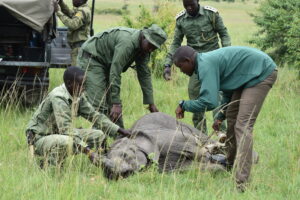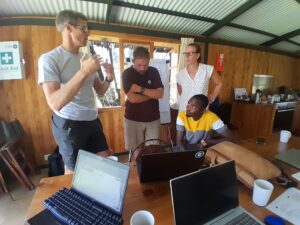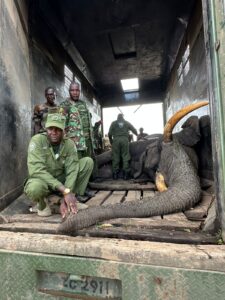In December 2019, the Taronga Conservation Society Australia granted Mara Elephant Project Trust 8,430.26 AUD ($5,656.70 USD) to cover the deployment costs of five elephant collars in the Mara in 2020, as part of the Taronga Field Conservation Program. Kenya Wildlife Service (KWS) and MEP successfully deployed all five elephant collars in 2020 despite additional challenges presented by COVID-19. The four newly collared elephants and one re-collared elephant are all crucial candidates for KWS and MEP to collect data on and monitor how they move in the ecosystem.
The first, David was collared in August 2020 in the southern area of Olderekesi Conservancy near Cottars 1920s Safari Camp. He belonged to a small group of bull elephants going into settlement areas and raiding tomato farms along the Sand River. He’s providing data that is used daily to mitigate human-elephant conflict and inform ranger deployment in this area. In the long-term, the movement data this elephant generates will help us better understand the connectivity between the Maasai Mara National Reserve along the Sand River into the southern Loita Forest, an important area of operation for MEP rangers. The collar data is not only helping with the joint KWS and MEP security operations but is also building up a valuable database on the spatial movements and resource selection of elephants. Particularly useful are datasets that can show changes in movements over time in response to changing environmental and anthropogenic conditions.

David’s collaring operation in August 2020.
The second, Shamba, was treated for conflict related injuries and fitted with a collar to react to his future crop raiding. He was located in a historically high conflict area that’s heavily populated with many people farming right across the Mara River from the Ol Choro Oiroua Conservancy, a safe place for elephants to roam. Shamba was monitored until his time of death 10 days later. While the team’s joint efforts to treat and collar this elephant to save his life weren’t successful this time, if the elephant had not been collared, we wouldn’t have gotten to the carcass quickly enough to identify the cause of death; an important data point to collect in the Mara to protect future elephants. The MEP team was able to recover Shamba’s elephant collar to re-deploy in 2021.
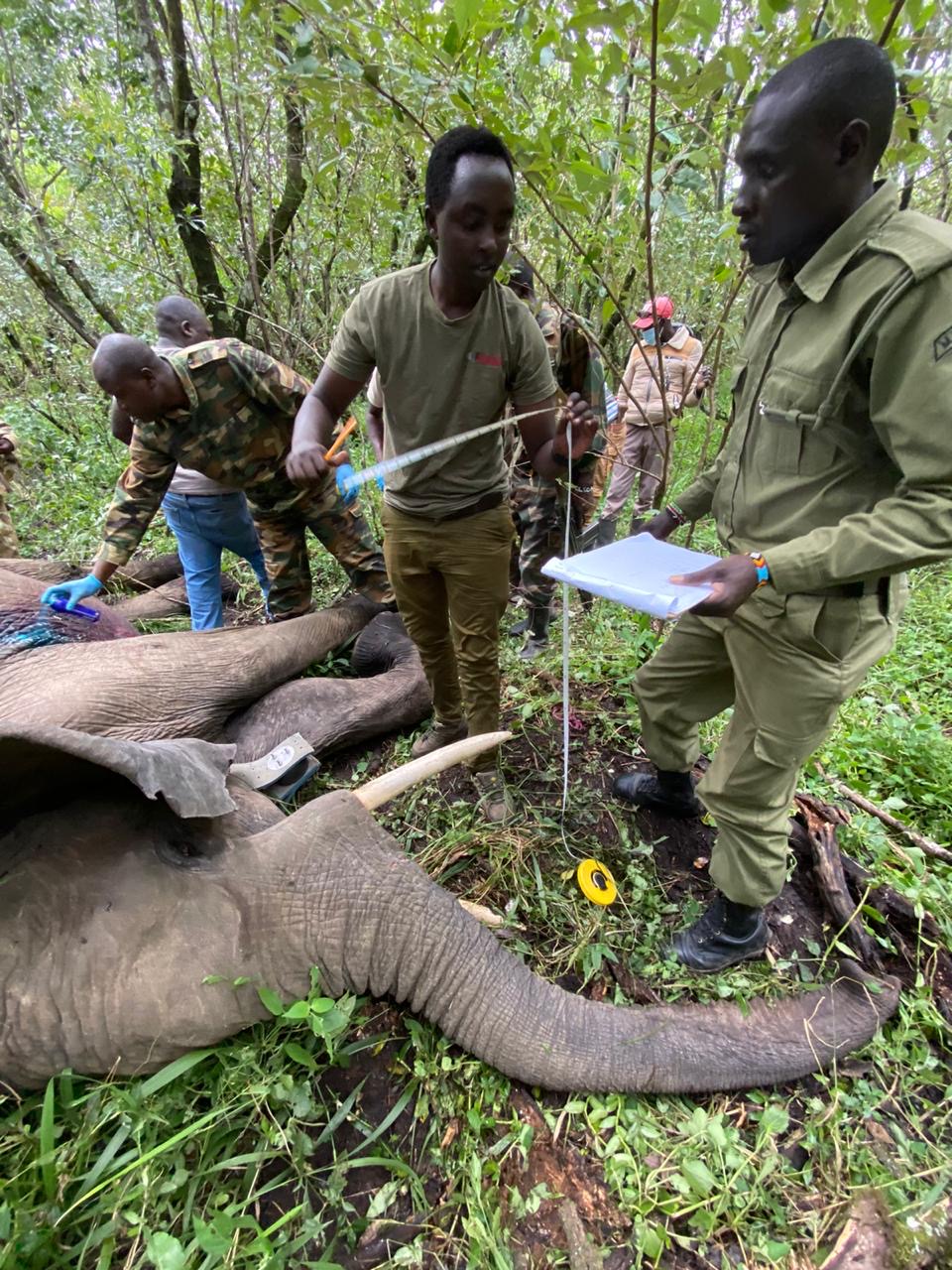
MEP’s Data & Reporting Manager Wilson Sairowua taking measurements during Shamba’s June 2020 collaring operation.
The third, Ritan was collared by KWS and MEP in June 2020, in the Sachangwan area of the Mt. Londiani forest block of the extensive Mau Forest Complex in Molo, Nakuru. This portion of forest is no longer connected to the larger contiguous Mau Forest Complex; however, that doesn’t diminish the important need to protect it. Illegal loggers and bushmeat poachers threaten this area and its wildlife inhabitants and KWS has ground teams based in Nakuru that are reacting to conflict incidents regularly. Ritan’s tracked movements allow MEP and KWS to rapidly respond to increased human-elephant conflict in the area and collect important data for future land use planning. Already, Ritan has been crop raiding in the Molo area and KWS rangers nearby have been using the collar data to respond.
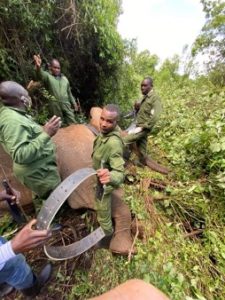
The fourth new collar went on a KWS and MEP elephant candidate that is helping us gather useful spatial data (pictured left). Harriet’s movements are building a case for support to protect this key corridor in the Mara. In the south-eastern portion of the Mara ecosystem, the Sand River area that connects Loita to the Maasai Mara National Reserve is an important source of surface water for elephants and all wildlife and provides a critical corridor for them to move into the Loita Forest during times of drought. The river is also key for the surrounding communities who use it as a source of water and who farm tomatoes along its banks, which leads to conflict as the people and wildlife are competing for the same resource. Previous data has shown elephant connectivity from the Mara to the Loita Forest through this area, but our goal with an additional candidate is to collect more movement data to use to help in landscape planning to maintain connectivity along this southern route.
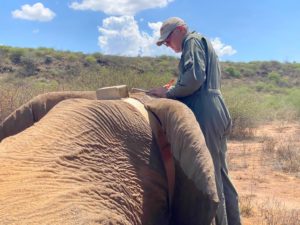 The fifth elephant collar deployed thanks to Taronga’s field grant was a re-collaring operation for an interesting candidate named Hannibal. Pictured left: Hannibal re-collaring with CEO Marc Goss. He was originally collared due to his proximity to Nairobi, but once collared by KWS and MEP, his movements showed him moving out of Nairobi and into the Suswa and Mosiro areas of the Rift Valley, an area of high conflict. He has actually joined up with another collared bull elephant in this area, Napoleon, and often MEP is called in by KWS to help respond to conflict in the Rift Valley caused by them. In response, KWS and MEP are using the elephant’s movement data to establish geo-fences that will give an early warning of crop raiding elephants nearby. In November 2020, Hannibal’s collar started to show a low battery alert due to faulty hardware and immediately needed to be replaced in order to continue his long-term monitoring. On November 25, KWS and MEP successfully re-collared Hannibal.
The fifth elephant collar deployed thanks to Taronga’s field grant was a re-collaring operation for an interesting candidate named Hannibal. Pictured left: Hannibal re-collaring with CEO Marc Goss. He was originally collared due to his proximity to Nairobi, but once collared by KWS and MEP, his movements showed him moving out of Nairobi and into the Suswa and Mosiro areas of the Rift Valley, an area of high conflict. He has actually joined up with another collared bull elephant in this area, Napoleon, and often MEP is called in by KWS to help respond to conflict in the Rift Valley caused by them. In response, KWS and MEP are using the elephant’s movement data to establish geo-fences that will give an early warning of crop raiding elephants nearby. In November 2020, Hannibal’s collar started to show a low battery alert due to faulty hardware and immediately needed to be replaced in order to continue his long-term monitoring. On November 25, KWS and MEP successfully re-collared Hannibal.

Hannibal and Napoleon are involved in regular conflict.
Overall, despite challenges in 2020, Taronga Conservation Society Australia’s support of the deployment of five elephant collars helped MEP respond to conflict and increase protection for wildlife and habitat.
